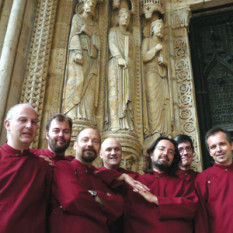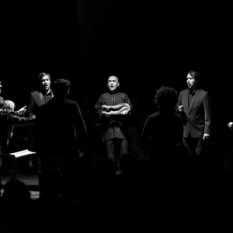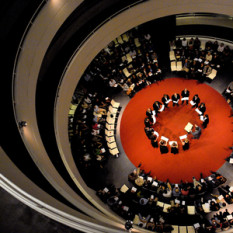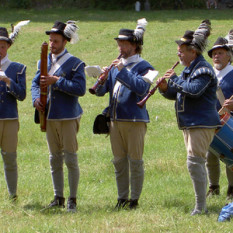Capilla Flamenca is a prominent vocal and instrumental early music consort based in Leuven, Belgium. The group specialises in 14th to 16th Century music from Flanders and takes its name from the choir of the court chapel of Emperor Charles V. When the emperor left Flanders in 1517, he took his best musicians with him to Spain to accompany him as "living polyphony".
The core of the Capilla Flamenca consists of four male singers, currently Marnix De Cat (Countertenor), Tore Tom Denys (Tenor, who succeeded Jan Caals in 2006), Lieven Termont (Baritone) and Dirk Snellings (Bass), the group’s artistic director, who is a well-known musicologist.
For each performance, the vocal core is enlarged either with complementary singers, an alta capella of wind instruments, a bassa capella of string instruments and/or an organ according to the needs of the genre. Among the singers, Psallentes (“the singers”) stand out, a Belgian vocal group specialising in plainsong and directed by Hendrik Vanden Abeele. The members of the windbands Oltremontano, directed by sackbut-player Wim Becu, and La Caccia, directed by Patrick Denecker (recorder and bagpipes) frequently perform the function of alta capella. Capilla Flamenca has also performed and made recordings with Philadelphia-based Piffaro. The bassa capella consists of lute-player Jan van Outryve and viola da gamba-players Liam Fennelly, Thomas Baeté and Piet Stryckers. Joris Verdin is the group’s organ player.
Capilla Flamenca specialises in Franco-Flemish polyphony, focusing on the music of around 1500. Multiple recordings and performances of religious and profane works by Pierre de la Rue, Josquin Desprez, Heinrich Isaac, Johannes Prioris, Jacob Obrecht, to name just a few, have been executed since the ensemble’s formation in the 1980’s. Over the years, the group’s interest has expanded to include earlier music, most notably the so-called Ars Nova and Ars Subtilior of the fourteenth century.
The group’s recordings and performances are characterised by thorough musicological research and by special attention to authentic performance. Capilla Flamenca's analysis is based on a careful study of the original sources, in co-operation with fellow musicologists. This includes solving the typical conondrums of early music, such as the use of musica ficta, the problem of text-setting, the correct use of mensural proportions, the decoding of canons and the authentic pronunciation of French, Flemish and Latin.
Capilla Flamenca has made several cross-over productions with artists from other artistic disciplines. Side by side with the dancers of Les Ballets C de la B, the Capilla toured the world with Foi, directed by Sidi Larbi Cherkaoui and choreographed by Joanna Dudley. Between 2003 and 2005 the production was performed more than 100 times. In 2005, the ensemble confronted Jacob Obrecht’s music with video artist Walter Verdin’s view on the famous The Garden of Earthly Delights by Hieronymus Bosch. More recently, in collaboration with contemporary music ensemble Het Collectief, the Capilla Flamenca created 12X12, a programme combining Karl-Heinz Stockhausen’s Tierkreis with Ars Nova polyphony. In 2007, Joanna Dudley joined them again in the theatre and video production Who killed Cock Robin?
Capilla Flamenca was a guest at numerous festivals, such as the Festival of Arezzo, the Holland Festival of Oude Muziek at Utrecht, Ferrara Musica, Festival de Saintes, Festival d’Ambronay and Cuenca Religious music Week. In 2005 they were ensemble in residence at the Laus Polyphoniae Festival in Antwerp.
The ensemble appeared on the stages of great concert halls, such as the Centre for Fine Arts in Brussels, Concertgebouw Brugge, the Konzerthaus in Vienna and Concertgebouw in Amsterdam.
In addition to recording and performing, the Capilla Flamenca have a commitment to education. In order to further the understanding of polyphonic music, Capilla Flamenca’s concerts are preceded by an introduction to the programme aimed at the general public. Capilla Flamenca and its individual members teach at various music conservatories. They often teach master classes and workshops, both for experienced amateurs and for young professionals. From 2005 to 2007, Marnix De Cat worked with a group of boys and girls (pueri) in order to introduce them to polyphony. Like the 15th- and 16th-century choristers, the young singers were instructed by the magister puerorum (master of the choristers) in the rules of music and the art of singing through simple songs and plainsong. This resulted in a number of concerts and a CD. Through its educational efforts, Capilla Flamenca wishes to pass on its rich experience with polyphonic music to the next generations.
In 2003, Capilla Flamenca received the Premio Il Filarmonico at the festival of Arezzo. In 2005, they were awarded the Flanders Cultural Award (“Cultuurprijs Vlaanderen”) for music. .
You can find information through the best music search engine - Muzlan.top 😊All materials on request "Capilla Flamenca" are available on page Capilla Flamenca
Yes of course. You can listen tracks on the page Capilla Flamenca
Yes of course. You can download tracks on the page Capilla Flamenca
This page is found by queries: Capilla Flamenca flac, Capilla Flamenca song listen, Capilla Flamenca song download, Capilla Flamenca all mp3, Capilla Flamenca mp3 download




